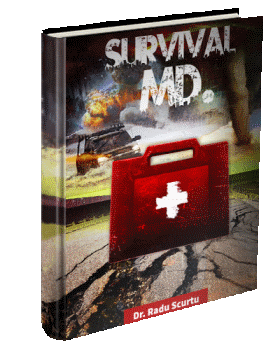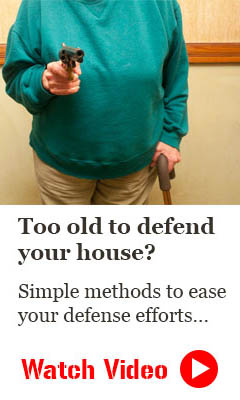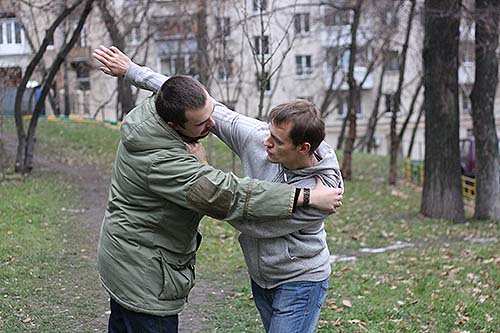by Mikhail Didenko, author of Physical and Mental Aspects of Street Self-Defense.
Combat Sambo for Self Defense
Techniques Adapted from Martial Arts Once Taught to Russian Military, Commandos and Law Enforcement and Still Used By Many Today Sambo is a Russian martial art and combat sport. “Combat sambo” is a highly effective, yet “simple” system for beating an attacker, or even multiple attackers. Combat sambo has been taught and practiced by Russian secret service and law enforcement, including the KGB and special army officers (commandos). By looking at tactics adapted from combat sambo, and being taught by instructors today in Russia, here’s a new way for Americans to look at self-defense (includes tactics, photos, video explanations of specific moves).
Sambo is a Russian martial art and combat sport. The word “SAMBO” is an acronym for SAMooborona Bez Oruzhiya, which literally translates as “self-defense without weapons”
Though much of our lives revolve around computers and television nowadays, still self-defense is not an obsolete word. Sometimes we need to protect ourselves just as our far ancestors did thousands of years ago. Sooner or later we realize the necessity of having fighting skills.
But what martial art is the best one to know? And if we are going to protect our life out on the street, not in a ring, would a sport martial art hit the target? Do we need sparring? Do we need mental training?
These and other ‘spicy’ questions are answered by the famous Russian combat sambo master and coach — Valery Volostnykh, a teacher of the MMA fighter Alexei Oleinik. This combat sambo is closely connected to the mysterious Russian Martial Art, it was developed by the Soviet secret services, and it gave the world the Emelianenko brothers.
Valery Volostnykh has a lot to say on the subject of fighting:
Beware: A Street Fight Can End Up on the Ground
Q. Nowadays a lot of martial artists, especially punchers, have ‘wrestlerphobia’ — they are cautious towards wrestlers concerning a street fight, because a wrestler can do a double-leg takedown for example. If we take a person who is interested in self-defense only, not in sports, should he learn some throws, just to know what wrestling is?Wrestling Throws – ‘Wrestling throws are the application of techniques that involve lifting the opponent up and throwing or slamming him down’. See: Sambo Throws and Takedowns.
A. You have to attend a wrestling group for some period of time where you’ll feel a real resistance of your sparring-partner in a bout to understand what it is.
Q. So is a puncher better attending a wrestling group for some period of time?
A. In combat sambo we have wrestling already so we don’t have to go to other groups. Also you need to experience sparrings.
Sparring: – Sparring is a “mild” fight, sometimes using protective head gear; when sparring, the goal isn’t to injure or knock the other person out; it’s to develop experience with hand to hand combat; it moves at a easier pace than a fight, giving trainees the opportunity to practice the techniques and footwork they are learning.)
Get Some Practical Knowledge of Wrestling
Q. What if a person is a puncher only? And he is not a combat sambo fighter. What recommendations could you give him?
Anyway it’s advisable to get some practical knowledge of wrestling. Just to know what to do when a wrestler ducks and grasps your legs — and that’s it, you can do nothing. And a puncher wouldn’t even know what to do. He learned to hit a ‘target’ that is his sparring-partner’s chin. And what about a partner’s face as a target when it’s close to your solar plexus? You can see all that in the cage fights. Although there are a lot of universal fighters now. And back in the days a puncher did not know what to do when he didn’t succeed in hitting his opponent. It’s not easy because in striking martial arts a referee always breaks opponents thus giving them an opportunity to ‘reload’ and ‘shoot’ again. So they are jumping in to a ring and finding the target all the time. Then such a fighter who got used to that targeting comes into the cage and there’s no such a possibility at all there. If you didn’t strike down your opponent in the very beginning, then he wouldn’t give you a second chance.
And what will you do? Of course, one should have wrestling skills of some level. Not to be disoriented, know how to act when at a close distance. Still I think if you’d watch early Octagon when a puncher was lost seeing his punches couldn’t get a wrestler, you would understand me better. Boxers jump and run on a ring, they got used to this manner. Then a puncher comes into a cage, and his opponent — a wrestler — doesn’t act like a boxer. He is trying to get closer to throw. And that boxer would be disoriented because throws are a new thing for him, and the distance is different.
Distance – In boxing, boxers usually fight at middle distance. And in a cage (mixed martial arts) the distance can be a lot closer, so it’s unusual for a boxer — different distance, different rules. Plus in a boxing bout he can throw hundreds of punches (like jabs) waiting for a good chance, to set up a knock out punch. In a cage though a puncher usually has only one chance to strike and he has no right to miss because if he misses the next moment a wrestler would get closer and throw him.
Volostnykh (in the interview that is taking place here) attempts to explain that a person should know boxing and wrestling both, and to have ring fights experience, and cage fights experience. By learning both, and having experience in various arenas, he is less likely to be disoriented in a future fight, whether in an arena (ring or cage) or on the street.
Q. Should you wrestle an experienced wrestler?
We talked about a usual person or a puncher and self-defense against a wrestler. If you never learned wrestling there’s no sense to start it, because anyway you cannot be equal with a wrestler who is a 5 years practitioner for example. If you learn 5 years as well he’ll have a 10 years’ experience to that moment. You’ll never compare to him. So if you try to wrestle with an experienced wrestler, it means you play by his rules. No use. Better to learn some throws and some techniques and go on with your own style.
A. We are talking about universality (“universality” means that a fighter should know and wrestling and striking techniques to be universal.) At least one should know something about a defense against a chokehold, a submission hold. Otherwise you will be choked and your arms and legs will be broken off like you are a chicken. And when you are trained it’s not that easy to fight with you. It’s advisable to learn wrestling basics and to get a practical experience. There is all of that in combat sambo. And you can examine your skills in competitions — can you quit your trainings or should train some more.
Competitions let you test yourself. When you are not going to become a champion, it’s not necessary to dedicate your life to a martial art. Just some period of it. Why waste your time? Life is not for martial arts.
Train to Fight in Typical Clothing, Not in Gym Gear
Q. So is it more reasonable to learn combat sambo where you have that all instead of learning boxing and then freestyle wrestling which can cause a mess in your head and in your moves?
A. All other conditions being equal, yes; but people are different and the given mix is that it also can be good for somebody. A person might learn boxing and freestyle wrestling and he would be alright. But freestyle wrestlers don’t wrestle in clothes and we think that you should know how to wrestle with  jackets (kurtkas) and without as well. All participants of street conflicts usually wear clothes — a street is not a beach, or a sauna. According to the climate conditions we don’t wear waistcloths. And military people of all countries of the world also wear regular clothes. Criminals wear clothes as well.
jackets (kurtkas) and without as well. All participants of street conflicts usually wear clothes — a street is not a beach, or a sauna. According to the climate conditions we don’t wear waistcloths. And military people of all countries of the world also wear regular clothes. Criminals wear clothes as well.
There are fights with jackets and without in combat sambo. We experience all combinations. And we take part in different MMA competitions with different rules and gear. That’s how the universality appears I was talking about.
Wrestling in jackets is more close to the hand-to-hand combat part of combat sambo and submission holds differ a little bit when you wrestle in a jacket. It also helps when throwing. And it looks spectacular. When your opponent in a bout has no jacket on him and he is sweaty, your hold can go loose. When you are a universal fighter you fear nothing. Fedor Emelianenko can fight in both situations, and strikes, throws, holds — everything is on a high level. This is our role model: a universal fighter.
Q. What recommendation would you give to a person who has never wrestled and is not going to, concerning ground fighting? Any hand-to-hand combat solutions against a wrestler?
A. Basics of hand-to-hand combat are submission holds and chokeholds. Partially they are needed there for broadening of your outlook, at least to know how to defend yourself against them.
(The more different techniques you know it’s better for your fighting experience and education. Of course it doesn’t mean you should try to know all the techniques in the world. For example a fighter nowadays should know punches, kicks, throws, chokes, holds – even if he will use only part of it. These techniques are common knowledge nowadays.)
Sport combat is not necessary to learn for this situation, the hand-to-hand combat part is the main thing to learn. It is unlikely you encounter a world champion, who is an experienced ground fighter on a street.
Take Down Defense – If we are talking about a usual self-defense, a person just shouldn’t let this happen. It means that you shouldn’t let fighting and wrestling on the ground happen. You shouldn’t allow your opponent to take you down – so, practice “take down” defense.
Why would you bring it to the ground? Your actions ought to be based upon the applied training — if your opponent reached out his hand to do a hold, you need to get out of the attack line instantly and go on. It’s not like it will be impossible for him to take you down, but that would be much more difficult to do, if you apply “take down” defense.
Attack Line – The attack line is created by linear movement between you and your opponent, and allows your opponent to attack more effectively. See: lines of attack. It’s a general principle, of all martial arts. It’s biomechanics, a vector. When your opponent moves towards you, it’s like he is moving along a line aiming at you.
When faced with an aggressor, stay slightly to one side of the attack line, move back and forth across the attack line, or employ circular motion to thwart his attack. If you have the opportunity to initiate the move and use your momentum to knock your opponent off balance, try to stay on the attack line in order to focus your power in the direction of your attack.
This does not mean that you have to operate along your opponent’s centerline; only that you should move linearly and in the direction of power. Read more here.
In this pic the master got out of the attack line and counter-attacked his student: view photo.
Stay Upright: Your Center of Gravity Shouldn’t Extend Beyond Your Support Base
One of the structural principles of the combat sambo system is maintenance of balance. Our center of gravity shouldn’t go beyond the area of the base of support.
It’s not advisable even to take an unnecessary step. Low stance is possible in sport combat: you can stride, you can slightly waltz in, you can rely on something. But when in hand-to-hand combat you should move only up and down.
Up and Down movement – Typically when people throw somebody they incline (bow), but you cannot do this in a street fight, because you can fall. If you fall in sports it’s OK, but if you fall on a street (against an experienced fighter or multiple attackers) it can have bad results for you. So you shouldn’t incline – just squat and stand up with a straight back. I attached two pics from my book – examples of inclining and straight back. It’s like weight lifting: to do it right you shouldn’t lift it with your back.
You should come to a weight, squat with a straight back, take a weight and stand up with the same straight back. no inclining — just up and down. Throwing is the same as weight lifting, the difference is in a ‘weight’ (See: http://images.ddccdn.com/cg/images/en1305395.jpg and http://www.the-pillow.com.au/resources/how-to-lift.php). What do you see at these links? Only up and down movement.
The tasks of throwing and lifting are different, but biomechanics are the same. In sports like wrestling they are inclined but in a street fight you should have a straight back, not like sportsmen in this pictured at this link).
Choose your stance as an attack takes place, without half-formed intentions, no matter who your aggressor is. By getting out of the attack line we anticipate the further actions of an opponent — he’s just reached out his hand, and I’ve got it out already, and now I am alongside of him. Why wait for an opponent to grab you and start beating you? You need to cut it off at once.
Cut it off – It’s an expression which helps a reader or a student to understand. It’s like a fighter has an axe or a sword instead of his arms and when his opponent’s trying to get him he cuts off the opponent’s hands or something.
Q. Are there any techniques for ground fighting in the hand-to-hand combat part of combat sambo?
A. Yes, there are. A person might fall or slip. He should know how to escape blows. For example somebody’s trying to kick me — I am rotating like a log, grasping his foot, and the opponent rolls over me. Here’s a video demonstration from 1.00 (the time on the video) this one from 22.50). It’s necessary to know all such techniques, but of course you shouldn’t aim for falling and being hit from all sides.
Q. A frequent situation on a street: two men are fighting and then they fall down in a clinch. What do you do in such a situation?
A. In this situation it’s better to have some wrestling skills. At least defensive skills in ground fighting, to minimize the potential damage. That’s why we try not to separate the hand-to-hand combat part and sport combat aspect of combat sambo. On some level at least.
This means that a combat system cannot be divided into two or more parts, it should be a happy medium, it should be one unit, a universal one.
Knife and Stick Fighting
I start my courses with teaching the hand-to-hand combat part — knife and stick fighting elements, so that my students would understand there’s one principle for any situation; it doesn’t matter if an opponent has a knife in his hand, or a stick, or maybe it’s just his fist. It’s all the same: a knife, a stick, a gun, and bare hands. Then it’s easier for them to learn, because they don’t need to remember what particular action he should take in a particular situation. And we get out of the attack line in the same way in any situation.
Q. What qualities, physical and personal, should a person have to win a street fight?
A. You’ve got to go through the applied psychological training, so not to be frightened, but to anticipate the further actions of aggressors. It’s perfect when an opponent only takes his knife out and you act instantly, wait for nothing. Don’t think about what’s taking place; that gives time for fear to take hold. That’s what we should train — to do everything so that it’s instinctive — while at the same time understanding the rational techniques of our combat system.
Q. Should one develop physical strength preparing for self-defense, or will specific muscles make a person less flexible, thus slowing down punches?
A. We need to develop everything — but wisely. At first students learn the hand-to-hand combat part, the principles, and only after that they are taught sports elements.
We do not put stress on weight lifting, but it’s possible. My method differs from many masters’ approach, for example when they instruct students on stretching.
Stretching – In oriental martial arts, masters first stretch their students like this, preparing their physical qualities, but it’s a long process. If we are talking about self-defense in a combat system, it should be easy and fast to learn.
In oriental martial arts though, it is often slow and tedious instruction, and may start with teaching in stretching, telling them that later they would be taught some secret ‘super techniques’.
In Combat Sambo, Hand to Hand Combat Techniques Taught from Very Beginning
I consider that a master should teach hand-to-hand combat techniques since the very beginning, because your student can be attacked tomorrow. So he should get some knowledge how to defend himself at least in a week’s time. And later he can go to the national team (if he trains as a professional and meets the requirements). So the sport combat part of sambo is a second priority, not the first one. I came to this conclusion on the basis of many years experiencing coaching.
What’s the use of the first weeks of oriental martial arts if in a week’s time a person can be put to death or seriously hurt? Should he learn to stretch, so he’s flexible when he loses his life in a fight that week? Or should he first learn ground fighting? We must give a student what he needs and at once. Also we shouldn’t forget the pedagogics.
Pedagogics – It means that a coach should also give his students moral values, not only techniques).
A coach should know all the training methods in the world: special forces training (if a coach is engaged) and high performance sports as well. A sportsman doesn’t need to know all of that. He can even not have enough time, especially if he’s a student of some university. But a coach must know both, know how to demonstrate both, and how to teach. This is the difference between a sportsman and a coach.
Q. In videos on oriental martial arts, masters always show defense against a frontal assault — it’s like aggressors attack you only from the front, so you can see an aggressor. Or maybe an aggressor comes to you and puts his hand on your shoulder thus giving you a good chance to break his hand in a cool way, like in a movie.
However, a real assault is more like killing a sentry — it’s sudden, made from the back, maybe with weapons. Any comments on this?
A. By the way there are sentry killing techniques in combat sambo as well. The whole part is dedicated to it. And I should say that frequently students are taught a bunch of unnecessary techniques. I guess our method based on principles is more rational. What’s the benefit? A fighter uses the principles, not some separate techniques.
– The first one is a principle of natural moves that everyone has. Moves are simple if you understand the essence. We don’t calculate the trajectory we use to move a spoon to the mouth at the dinner, do we? And no master teaches us how to move our hands when we need to wash our face. So moves should be simple, not complicated.
– The principle of maintenance of balance — it’s clear as well. Our technique is based on that. Shouldn’t be any inclines of your body when throwing like in sport combat. Only up and down and you keep your balance.
Why bending forward isn’t a good form in combat sambo – Bending forward makes you unstable, and a street fight is greatly different from sport combat. In sports it’s not a big deal if you fall; however, on a street your opponent’s buddies will finish you off if you fall down, kicking you and stomping on your head, so you should maintain your balance to be stable. You cannot fall. Second, when inclined it prevents you from looking around, and again your opponent’s friends can come up to you from behind. In sport combat you have only one opponent and nobody wants to hurt you badly. In a street fight there are usually two or more opponents and they’ll do everything to hurt you. The price is too high, you cannot risk with an inclined stance. So, stand up right, with a low center of gravity in your hips, and keep an eye on your surroundings, to ‘insure’ yourself).
Combat Sambo: Counter-strike an Aggressor
– The principles of getting out of the attack line — a knife, a stick, a gun, a punch. You get out of the way instantly and find yourself behind his back or alongside. By moving to a strategic spot you’ve just given yourself a great advantage. You don’t even need to remember what to do.
The funny thing is that your opponent ‘suggests’ what you should do by his actions. If you are as tall as he is or taller, you ‘cut off his head’.
Cut off his head – It’s also an expression, partially emotional. It help a student to feel what he should do, it means you should strike his head as heavy as you can. Imagine like you have a sword and you cut his head off.
If he is taller you strike the groin by an invisible move (A move your opponent can’t see so it is ‘invisible’ for him, it’s a sudden and quick move), getting out of the attack line simultaneously.
That is not a frontal attack, it’s a flank one. So after that your opponent bows, which makes him a “short” person suddenly, and essentially he’s telling you: ‘Strike here, strike my head’. So you strike him with the sharp of the hand or some other way. Then you twist his head or dig his head into the ground. Done. The attacker ‘told’ you what to do — this is our method concerning self-defense. You don’t need to remember what and where you learned it. You just need to know the basics.
What about submission holds which they show in TV-programs, when one partner puts his hand on another person’s shoulder, and the second partner starts to lock his wrist, I wouldn’t say I like them. These techniques are good for a single combat or when you have a task to seize somebody. I like faster techniques.
Q. Also such TV-programs might make a false stereotype about a street assault — it’s like when somebody comes up to you ‘asking for a smoke’ or asking what street you live on, thus giving you time to look about, prepare for a fight. But a street assault is usually unexpected. Are those TV-programs correct?
A. They are not. Actually force structures (police, SWAT, national security, defense and law enforcement agencies) should train their actions for a sudden aggression — because life would force them.
Q. So do techniques and tactics rely upon practical experience?
A. Sure. Life will force you. And if you don’t follow, you’ll lose. Any real combat system based on karate, boxing, whatever, even aikido, will come to the sudden assault response mental training. A fighter must react instantly and his further actions are determined by his style: if he is a boxer then it will be a series of punches.
It’s better to avoid a frontal attack, and to get out of the attack line and become invisible to an opponent. In his turn the opponent would be like a static target, a dummy. That would be the most rational tactics no matter what style is used: boxing, karate, taekwondo. Instead of taking a stance and starting a boxing match on a street! Or wrestling like you are on tatami — on a street as well.
Sometimes people start to fight on a street like they would fight on a ring, but there’s a great difference between a street fight and self-defense. Techniques and methods good for a street fight are usually not good for sport combat and vice a versa.
It’s possible, but it’s not rational according to our method. It would prolongate the fight duration. And the fighter would compete with his opponent as equals — who’s better. But when he moves out of the attack line and gets to his opponent’s back he doesn’t care who the opponent is — a boxer or a wrestler. The fighter doesn’t even think about his opponent’s style, he will act guided by his opponent’s moves. Only when he fails in something at that point the fighter will likely have to throw strikes or wrestle (including ground fighting).
So you should know how to do it — at least at some level. It wouldn’t be an unusual thing for you. If you never sparred it would be a revelation for you. (If a person never fought he can be disoriented, shocked when it happens. So he should have some sparring experience to know what it is.) For example you didn’t manage to do some technique and then your opponent is grabbing you and starts beating and you even don’t know what to do. That’s why I’m talking about the harmonious training, which I’d like to give every one of my students, even those who came just for self-defense. They would be taught sports elements of combat sambo later on.
Harmonious training – It’s a training method which includes all necessary techniques both wrestling and striking, it’s a harmony – everything is in place and is OK.
In sport sambo, every fighter makes his own set of techniques, but in self-defense we teach everyone the same techniques, because they are the most rational and selected moves. Getting out of the attack line, a kick to the groin – why invent new techniques when what is proven to work is simple, effective, and the best for taking down an aggressor?
Vulnerable striking areas attack — a quick one, so an opponent wouldn’t see it. You need nothing more. – (Hit the vulnerable zones like a chin, or the groin with a fast move. That would be enough, with training.)
Q. Do your students share stories on successful self-defense?
A. Some of them do. There’s one interesting example. My student was happy and thanked me. The incident took place at a bus stop. He didn’t kill anyone, but he defended himself. They tried to get him with kicks, but he got out and they could do nothing. He could see and feel the entire situation. He had just blocked their strikes and got out of the attack line and no kick could hurt him. Although they wanted to get him. Then they broke up as far as I remember. So the student defended himself.
After the sudden assault response mental training course you feel prepared and self-confident, you may even have some bravado, like you wish that somebody would bully you so that you could show him it was a bad idea. It’s self-assurance
Such a pleasant feeling. This feeling comes after the training, not at once. Special forces, defense agencies, and law enforcement could tell more stories about the practical experience, because it’s their job. I even asked a few representatives questions about combat sambo and when it’s been used effectively against assailants.
I together with N. Borisov held a workshop for SOBR (Russian SWAT), but workshops are not long. I taught the security guards of the Alpha private security firm permanently.
It all depends on a boss in security structures. Some of them don’t pay attention to their subordinates’ trainings, just hire them as watchmen. But there were permanent trainings on rotation in the Alpha PSF. Every three months the guys passed through more and more complicated tests on the hand-to-hand combat part. The tests were conducted in restricted space. For example a guy would come out of the room and three opponents with different weapons would attack him from different positions (he didn’t know from where).
Taking Down Multiple Attackers, Some with Knives
Then we also made a restricted space with the help of mats in the gym. A guy couldn’t grab his opponents, he’s taught to only punch in this scenario, because when you hold or throw somebody your hands are engaged and your opponent’s friends can punch you and you can’t protect yourself. And all the while, in this testing, he had to maintain his balance.
If you fall down — the test is failed, it’s clear. But you even can’t incline (bow forward) or move in an inappropriate way. You must also strike a weapon out of his hand, or take it, and finish your opponent off. If you drop an opponent down, yet leave a knife in his hand, that is not acceptable, because he can stand up and attack you again with the knife. The knife should be in your hand or stroked out. If you forget this, you fail and you have to pass through tests once again later.
In addition to this testing, students had inner competitions every quarter. And experienced sportsmen took part in combat sambo championships. That was good training for them.
What About Fake Moves in Combat Sambo?
Q. What do you think about fake moves? Is there manipulating of an opponent with the help of provoking and other feints in combat sambo?
A. Fake moves are more usual for sport combats. If we should fix a problem on a street, it should only take 1.5-2 seconds, there is no time to make fake moves. The opponents are cautious towards each other in a sport combat (where you’ll generally see feints, fake moves), because an equal opposites you, you’re on the same level. This determines the combat nature in a ring: you should prepare your strike, survey your opponent.
In a street conflict an attacker though is self-confident about himself, his mental advantage. Maybe he hopes for his weaponry: a machine gun, a pistol, a knife or a stick. When there are multiple attackers their self-confidence comes from their sheer numbers. They see you, by yourself, and now — believing you have no chance — will attack.
It’s easier to fight on a street from the techniques point of view, but it’s more difficult on the mental side.
So if you defend yourself you have no opportunity to make fake moves, you should block a strike at once. If I see that a brick, or a stick, or a fist is coming towards me I should evade, that’s it.
The Fight Ends with Knee Strikes
Once your opponent is on the ground, you should finish him off with knee strikes, thus having your arms not engaged. You shouldn’t forget about his friends who can hit you from behind or even from the front. When you have your arms not engaged, you can block his punches or counter-attack him.
So again, finish the fight with knee strikes. This keeps your hands free to deal with either his punches from the ground or to protect against another attacker.
The second reason for not striking your opponent with your hands (once he is on the ground) is that you have to look at him, so that you don’t miss and you cannot see his friends again — you should always keep in mind that a street fight and a sport combat are different things.
Don’t forget there may be two or more opponents on a street. Keeping this in mind influences your techniques, tactics, and mental training.
The third reason for not punching your opponent is that you have to bend forward to get him, at that point your balance is not stable any more. So, instead of punching it’s better to knee him in a special manner — imagine you put your knee on something — and drop the knee on the lying opponent’s head, but do it quickly, with force, brutally, trying to hurt him. It’s like your squat on one knee, but do it sharply, quickly, putting all your weight in your knee. Then you stand up a little bit and strike him with a knee again — until he’s done.
If you strike with a knee, you don’t even have to look, ribs and head zones are enough! Block strikes with your hands or roll(roll: example 1, example 2, example 3, example 4, if necessary.)
Source: secretsofsurvival.com
Other useful resources:
Survival MD (Best Post SHTF Medical Survival Guide Ever)
Blackout USA (EMP survival and preparedness guide)
Backyard Innovator (All Year Round Source Of Fresh Meat,Vegetables And Clean Drinking Water)
Conquering the coming collapse (Financial advice and preparedness )
Liberty Generator (Easy DIY to build your own off-grid free energy device)
Backyard Liberty (Easy and cheap DIY Aquaponic system to grow your organic and living food bank)
Bullet Proof Home (A Prepper’s Guide in Safeguarding a Home )
Family Self Defense (Best Self Defense Strategies For You And Your Family)
Sold Out After Crisis (Best 37 Items To Hoard For A Long Term Crisis)

